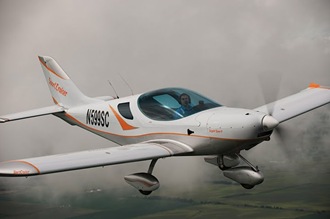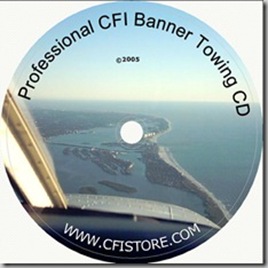From the pilot during his welcome message: "We are pleased to have some of the best flight attendants in the industry… Unfortunately none of them are on this flight…!”
Flying with grandpa video
Today is Father’s Day and we thought it would be great to post this video about a little boy who gets his first flight lesson from his grandpa while his dad watches from the back seat. The video was put together by dad who noted that his son is learning to fly on the same private strip where he learned to fly 23 years ago. The video also has some great shots of the area around Lake Geneva, Wisconsin.
The LSA industry: Time for adult supervision?
AndrewS, the founder of Hopscotch Air who flies an LSA (the Sportcruiser), has just written an interesting post on the Let’s Go Flying blog about the recent audit report from the FAA on the LSA manufacturing industry which is setting off alarm bells to the point where even Dan Johnson, the chairman of the Light Aircraft Manufacturers Association, said it was “tough love.” However, Andrew further added that he thinks the report is a bit more ominous than that.
Apparently, the FAA audited 30 LSA facilities to determine if they are complying with ASTM standards (the ASTM is an independent group that various industries use to set standards for their products) as under current rules, if an LSA meets these standards, it can then be sold to the American public – without government certifications. However, the FAA determined that most of the thirty facilities audited could not establish that their aircraft met the standards and that they have failed to implement basic internal controls and don’t full understand FAA regulations. The report concluded that the FAA needs to increase its oversight of the LSA industry.
Andrew then pointed out that the FAA and the NTSB do not have any issues (so far) with the safety record of LSAs but then again, there aren’t many flying right now. However, all it will take is one or two serious accidents that would then lead to a significant government crackdown and new regulations. Hence, Andrew concluded that the LSA industry must immediately answer all of the FAA’s concerns that if the LSA industry “cannot instill it’s own adult supervision, we all know the government will do it for it.”
Hence, we want to know what you our readers think of the LSA industry. Does the LSA industry really need to clean up its act and if so, can it do it on its own? Or does it just need more “adult supervision”?
Brightline Flying Bag review (Video)
I got a Brightline flying bag on Saturday and I thought it would make a fun video review using my new camera.
(It’s all toys, all the time here at GHW HQ!)
Would you want to become a pilot for a living now?
Scott Spangler has written an interesting post on JetWhine where he noted a recent NPR story about the dwindling number of student pilots in the USA. Apparently, it is being reported that the FAA’s estimate for this year’s number of student pilot certificates will total less than 60,000 – an all time low. For some perspective: Student certificates peaked at 209,406 in 1968 (around the height of the Vietnam War) and then reached an all-time high of 210,180 in 1979. Since then though, they have been in decline and fell into the five figures in 1994.
Scott noted that he often receives plenty of questions and genuine interest about becoming a pilot from youngsters but their interests is mostly fueled by having played video games and from seeing Red Bull Air Racing. However, the NPR story also profiled a CFI and aspiring professional pilot who is the perfect example of why pilot numbers are in decline:
His loans total nearly $100,000, and to build the experience that will qualify him for a $20,000-a-year right seat in a regional airliner, he’s forced to “flight instruct, tow banners, and haul skydivers.” Think about the attitude bred by this decades-old system and the declining student and pilot population should surprise no one.
In other words, why would anyone want to become a professional pilot under those conditions? However, Scott noted that the US aviation industry only makes changes when it is forced to but then he suggested that:
A good solution might be the military model, where candidates vie for a coveted seat, knowing they will receive top-notch proficiency-based training designed for the mission they will soon fulfill. Anyone can apply, but only the best will be chosen for the education program that fills a guaranteed professional pilot slot. Because the airlines would have more invested in their pilots, perhaps they wouldn’t treat them like Doritos: Hard financial times? Furlough them! There will always be new suckers who still believe in the happy airline pilot dream.
Hence, we want to know what our readers think – especially any USA based pilots who fly for a living. Would you choose to become a pilot again or choose a different line of work? What do you should be done to reverse the decline in pilot numbers?
Why Belite loves carbon fibre
This is a guest post from James Wiebe from Belite Aircraft.
We manufacture ‘FAR Part 103’ ultralights. On the English side of the pond, they are called ‘SSDR’ aircraft. (That’s ‘Single Seat DeRegulated’).
The common denominator of these aircraft is that they are simple own, operate, and enjoy!
I thought I’d try and show you how we are able to innovate, in order to produce a superior product.
At Belite, we incorporate state of the art technology into our aircraft – carbon fiber provides the ability to decrease weight while increasing strength. That’s important – especially if you are trying to hit an all up weight of 254 pounds in the U.S, or 10KG/SM wing loading in the UK.
One of the really nifty things about the ultralight aircraft is the regulatory freedom to explore innovative aircraft structures. As an example, Belite has recently been working on improved tail feathers for our aircraft. Our old design used conventional, trusty, 4130 chromalloy steel.
We’ve been using carbon fiber spars in our most advanced ultralight aircraft, for instance, our Belite Superlite. We are now incorporating carbon fiber into some of our tail feathers.
I’d like to show you the old fashioned way of doing tail feathers, which is steel. Have a look at some steel tail feathers:
Chromalloy steel can be welded into a thing of beauty, as shown in the photograph. The problem is that welding takes time and also takes the skill of a true steel artist. (Fortunately, we have such a welder on our staff.)
But carbon fiber has some very interesting properties.
First of all, Carbon Fiber is unbelievably strong.
In order to appreciate Carbon Fiber, it’s useful to understand steel. Let’s consider the strength of steel, so that we can understand how strong carbon fiber is. Steel has a tensile yield strength of about 63,000 pounds per square inch. That means that a one inch square steel rod can lift 63,000 pounds off the ground, without suffering structural damage to the steel.
Steel is pretty good stuff.
(Hey, we’re not considering anything but tensile strength here. There’s lots of other engineering considerations… but let’s keep it simple.)
Now – let’s take a look at Carbon Fiber. Carbon Fiber has a tensile strength of around five or 600,000 pounds per square inch. This means that the same small 1 inch square rod, when made out of pure carbon fiber, could lift 250 or 300 tons off the ground!
It seems like Carbon Fiber might make a pretty good material to manufacture aircraft parts with.
It also is a great material to make tail feathers out of! Take a look at this carbon fiber horizontal stabilizer structure:
This is a direct replacement for our steel tail feather. It has attachment points in the same spots, and can be used interchangeably with the original steel tail feather.
The benefits are as follows:
- This structure weights just 4 pounds, or 1.82 KG in KiloSpeak.
- This structure’s strength is considerably greater than the steel structure that it replaces.
- Due to the increased ‘thickness’ of this structure, this improved tail feather can incorporate a slightly more aerodynamic airfoil.
In other words, it’s just better. And of course, the downside is that it’s more expensive to manufacture. Oh well. Can’t have everything!
If you have any questions on carbon fiber, ultralights, or SSDRs, drop me a line. I’d enjoy talking with you. I also maintain a blog about ultralight aircraft. Please have a look.
Until next time, cheers from Wichita, KS (the Air Capital of the World),



